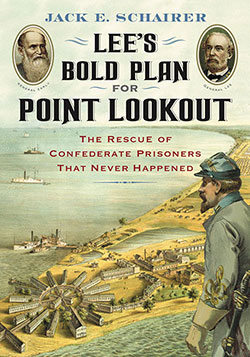Lee’s Bold Plan for Point Lookout
The Rescue of Confederate Prisoners That Never Happened
$39.95
In stock
About the Book
In July 1864, while hemmed in by Grant at Richmond, General Robert E. Lee conceived a bold plan designed not only to relieve Lynchburg and protect the Confederate supply line but also to ultimately make a bold move on Washington itself. A major facet of this plan, with the addition of General Jubal Early’s forces, became the rescue of the almost 15,000 Confederate prisoners at Point Lookout, a large Union prison camp at the confluence of the Potomac River and Chesapeake Bay. With international recognition hanging in the balance for the Confederacy, the failure of Lee’s plan saved the Union and ultimately changed the course of the war.
This work focuses on the many factors that contributed to this eventual failure, including Early’s somewhat inexplicable hesitancy, a significant loss of time for Confederate troops en route, and aggressive defensive action by Union General Lew Wallace. It also discusses various circumstances such as Washington’s stripped defenses, the potential release of imprisoned Southern troops and a breakdown of Union military intelligence that made Lee’s gamble a brilliant, well-founded strategy.
About the Author(s)
Bibliographic Details
Jack E. Schairer
Format: softcover (7 x 10)
Pages: 265
Bibliographic Info: 79 photos, maps, notes, bibliography, index
Copyright Date: 2008
pISBN: 978-0-7864-3555-5
eISBN: 978-0-7864-8930-5
Imprint: McFarland
Table of Contents
Preface 1
1. Introduction 3
2. Lee Was an Audacious Man 8
3. Plans to Capture Washington and Point Lookout 23
4. Trevilian Station 29
5. General Hunter Fails to Move in the Shenandoah Valley as Directed 36
6. Lee’s Bold Plan, Phase I 53
7. Early’s Fateful Decision 70
8. Washington’s Defenses Undermanned 74
9. Point Lookout Prison Camp Vulnerable to Attack 89
10. Early Tarries on the Upper Potomac 98
11. A Lack of Shoes Causes Delay 110
12. Grant Fails to Meet Early’s Threat 113
13. Early Hindered by Lack of Cooperation with Mosby 122
14. Washington’s Defenses Depleted by Removal of Troops to Maryland Heights 126
15. Seaborne Attack on Point Lookout in Conjunction with Early’s Forces Called Off 130
16. Wallace Aggressively Contests Early’s Move to Frederick 136
17. General Ransom Costs Early Time 143
18. Hunter and Howe Fail to Move to Threaten Early 147
19. Confederates Fail to Secure Bridge at Monocacy Junction 154
20. Early Delayed by Battle of the Monocacy 157
21. Johnson-Gilmor Raid Toward Baltimore and Point Lookout 164
22. Wallace’s Retreat to Baltimore Aids Early’s Advance on Washington 170
23. Hot Weather Slows Early’s Move on Washington 173
24. Early Loses Opportunity to Enter Washington at Fort Stevens 176
25. Veteran Reserve Troops and Convalescing Officers Help Defend Washington 185
26. Quartermaster Employees Serve in Washington’s Defense 192
27. Lack of Intelligence on Washington Defenses Handicaps Early 196
28. Actions at the Blair Mansions a Minor Factor in Early’s Failure to Enter Washington 200
29. McCook’s Force Outside Fort Stevens Deters Early’s Assault 205
30. Convalescing Union Troops Help Defend Washington 207
31. Lincoln Under Fire at Fort Stevens 210
32. Foreign Recognition of the Confederacy and Lincoln’s Problematic Reelection 213
33. Epilogue: Early Reconsidered 221
Chapter Notes 225
Bibliography 243
Index 251





